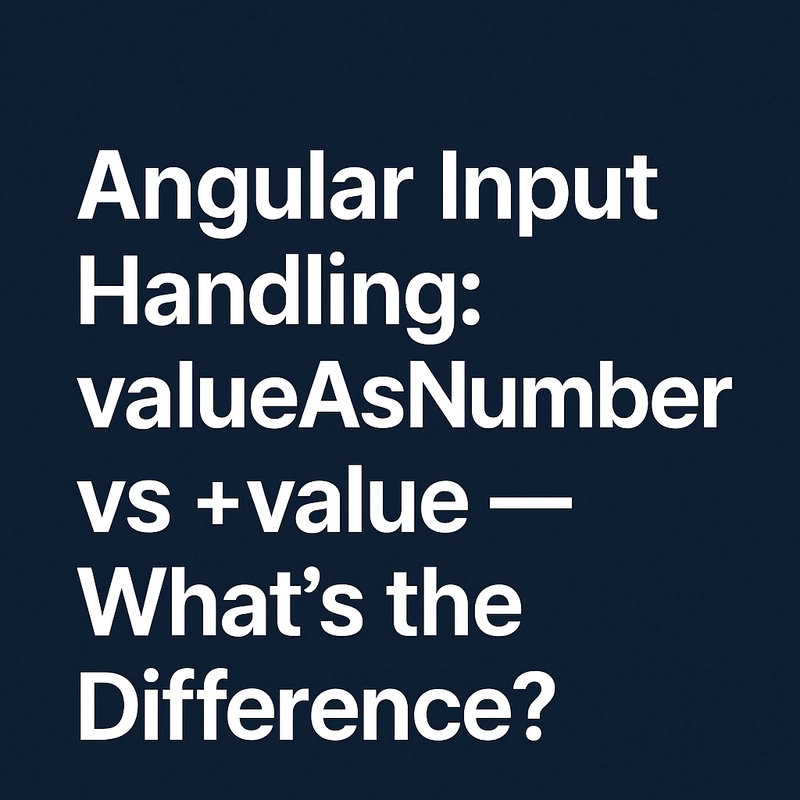Angular Input Handling: valueAsNumber vs +value – What's the Difference?
Angular Input Handling: valueAsNumber vs +value – What's the Difference? When handling elements in Angular—especially in combination with Signals or reactive state—you might encounter two common patterns to retrieve the value of a numeric input: At first glance, both seem to achieve the same goal: extracting a number from the input field. But under the hood, they behave very differently, especially in edge cases. Let's explore. Option 1: valueAsNumber valueAsNumber is a native DOM property available on elements. It directly returns the value as a number: Pros: Type-safe: Returns a number, not a string. Semantically correct: Designed specifically for numeric inputs. Handles invalid or empty inputs gracefully by returning NaN. Example: const input = document.querySelector('input[type=number]'); console.log(input.valueAsNumber); // 42, or NaN if empty/invalid Behavior: Input value valueAsNumber "42" 42 "" NaN "abc" NaN Option 2: +value (Unary Plus Coercion) In this approach, the value from the input is always a string. The unary + operator is used to coerce it into a number: +txtPower.value This works... until it doesn't. Cons: Prone to coercion issues: +"" becomes 0, which may be misleading. Not semantically tied to number inputs. Less readable and less intentional. Behavior: Input value +value "42" 42 "" 0 (⚠️) "abc" NaN Best Practice: Use valueAsNumber For numeric inputs, always prefer: txtPower.valueAsNumber Why? It accurately reflects the intention: working with numbers, not coercing strings. It produces NaN for empty/invalid input, allowing you to handle errors or validation more precisely. It avoids subtle bugs caused by JavaScript's type coercion model. Use Case with Angular Signal This binds the reactive value of power() and updates it directly from the number input. Summary Method Type-Safe Handles Invalid Input Recommended valueAsNumber ✅ Returns NaN ✅ Yes +txtPower.value ❌ Coerces empty to 0 ❌ Avoid Final Thoughts In modern Angular applications—especially with Signals and reactive paradigms—precision and type safety matter. The subtle difference between valueAsNumber and +value may introduce unexpected behavior, especially when dealing with empty forms or validations. Use valueAsNumber whenever you work with number inputs. It’s clean, predictable, and built exactly for this purpose. Happy coding, and may all your values be strictly typed! ⚡

Angular Input Handling: valueAsNumber vs +value – What's the Difference?
When handling elements in Angular—especially in combination with Signals or reactive state—you might encounter two common patterns to retrieve the value of a numeric input:
type="number"
[value]="power()"
(change)="power.set(txtPower.valueAsNumber)"
#txtPower />
type="number"
[value]="power()"
(change)="power.set(+txtPower.value)"
#txtPower />
At first glance, both seem to achieve the same goal: extracting a number from the input field. But under the hood, they behave very differently, especially in edge cases. Let's explore.
Option 1: valueAsNumber
valueAsNumber is a native DOM property available on elements. It directly returns the value as a number:
Pros:
-
Type-safe: Returns a
number, not astring. - Semantically correct: Designed specifically for numeric inputs.
-
Handles invalid or empty inputs gracefully by returning
NaN.
Example:
const input = document.querySelector('input[type=number]');
console.log(input.valueAsNumber); // 42, or NaN if empty/invalid
Behavior:
| Input value | valueAsNumber |
|---|---|
"42" |
42 |
"" |
NaN |
"abc" |
NaN |
Option 2: +value (Unary Plus Coercion)
In this approach, the value from the input is always a string. The unary + operator is used to coerce it into a number:
+txtPower.value
This works... until it doesn't.
Cons:
-
Prone to coercion issues:
+""becomes0, which may be misleading. - Not semantically tied to number inputs.
- Less readable and less intentional.
Behavior:
| Input value | +value |
|---|---|
"42" |
42 |
"" |
0 (⚠️) |
"abc" |
NaN |
Best Practice: Use valueAsNumber
For numeric inputs, always prefer:
txtPower.valueAsNumber
Why?
- It accurately reflects the intention: working with numbers, not coercing strings.
- It produces
NaNfor empty/invalid input, allowing you to handle errors or validation more precisely. - It avoids subtle bugs caused by JavaScript's type coercion model.
Use Case with Angular Signal
type="number"
[value]="power()"
(input)="power.set(txtPower.valueAsNumber)"
#txtPower />
This binds the reactive value of power() and updates it directly from the number input.
Summary
| Method | Type-Safe | Handles Invalid Input | Recommended |
|---|---|---|---|
valueAsNumber |
✅ | Returns NaN
|
✅ Yes |
+txtPower.value |
❌ | Coerces empty to 0
|
❌ Avoid |
Final Thoughts
In modern Angular applications—especially with Signals and reactive paradigms—precision and type safety matter. The subtle difference between valueAsNumber and +value may introduce unexpected behavior, especially when dealing with empty forms or validations.
Use valueAsNumber whenever you work with number inputs. It’s clean, predictable, and built exactly for this purpose.
Happy coding, and may all your values be strictly typed! ⚡




























![[Webinar] AI Is Already Inside Your SaaS Stack — Learn How to Prevent the Next Silent Breach](https://blogger.googleusercontent.com/img/b/R29vZ2xl/AVvXsEiOWn65wd33dg2uO99NrtKbpYLfcepwOLidQDMls0HXKlA91k6HURluRA4WXgJRAZldEe1VReMQZyyYt1PgnoAn5JPpILsWlXIzmrBSs_TBoyPwO7hZrWouBg2-O3mdeoeSGY-l9_bsZB7vbpKjTSvG93zNytjxgTaMPqo9iq9Z5pGa05CJOs9uXpwHFT4/s1600/ai-cyber.jpg?#)














































































































































![[The AI Show Episode 144]: ChatGPT’s New Memory, Shopify CEO’s Leaked “AI First” Memo, Google Cloud Next Releases, o3 and o4-mini Coming Soon & Llama 4’s Rocky Launch](https://www.marketingaiinstitute.com/hubfs/ep%20144%20cover.png)




































































































































































































![Rogue Company Elite tier list of best characters [April 2025]](https://media.pocketgamer.com/artwork/na-33136-1657102075/rogue-company-ios-android-tier-cover.jpg?#)








































































_Andreas_Prott_Alamy.jpg?width=1280&auto=webp&quality=80&disable=upscale#)



























































































![What’s new in Android’s April 2025 Google System Updates [U: 4/18]](https://i0.wp.com/9to5google.com/wp-content/uploads/sites/4/2025/01/google-play-services-3.jpg?resize=1200%2C628&quality=82&strip=all&ssl=1)










![Apple Watch Series 10 Back On Sale for $299! [Lowest Price Ever]](https://www.iclarified.com/images/news/96657/96657/96657-640.jpg)
![EU Postpones Apple App Store Fines Amid Tariff Negotiations [Report]](https://www.iclarified.com/images/news/97068/97068/97068-640.jpg)
![Apple Slips to Fifth in China's Smartphone Market with 9% Decline [Report]](https://www.iclarified.com/images/news/97065/97065/97065-640.jpg)



































































































































